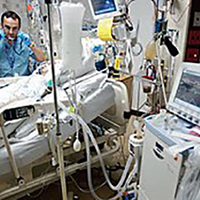Intubation and mechanical ventilation of patients with COVID-19: what should we tell them?

Published: April 8, 2020
Abstract Views: 7252
PDF: 3839
Publisher's note
All claims expressed in this article are solely those of the authors and do not necessarily represent those of their affiliated organizations, or those of the publisher, the editors and the reviewers. Any product that may be evaluated in this article or claim that may be made by its manufacturer is not guaranteed or endorsed by the publisher.
All claims expressed in this article are solely those of the authors and do not necessarily represent those of their affiliated organizations, or those of the publisher, the editors and the reviewers. Any product that may be evaluated in this article or claim that may be made by its manufacturer is not guaranteed or endorsed by the publisher.
Similar Articles
- Sabah Ahmed Hussein, Hari Kishan Gonuguntla, Sarabon Tahura, Belgundi Preeti, Vishnu G Krishnan, Nitesh Gupta, Ahmed Al-Halfawy, Felix J Herth, Flexible bronchoscopy-assisted removal of aspirated scarf pins from the tracheobronchial tree: the experience of 146 subjects , Monaldi Archives for Chest Disease: Early Access
- Rupak Singla, Amitesh Gupta, Vikas Kumar, Chandrasekaran Padmapriyadarsini, Devika Tayal, Shweta Anand, Abhishek Faye, AK Hemanth Kumar, Madhumita Paul Choudhary, Study of risk factors and clinical management of patients with clinical non-response due to low plasma levels of anti-tubercular drugs , Monaldi Archives for Chest Disease: Early Access
- Abhay Joglekar, Subhasis Roy Choudhury, Chandra Vibhash, Manisha Kumar, Amit Gupta, Risk factors and outcome of antenatally diagnosed congenital diaphragmatic hernia following in-utero transfer in a busy public-sector tertiary care center in North India , Monaldi Archives for Chest Disease: Early Access
- Vidushi Rathi, Pranav Ish, Gulvir Singh, Mani Tiwari, Nitin Goel, Shailendra Nath Gaur, Iron deficiency in non-anemic chronic obstructive pulmonary disease in a predominantly male population: an ignored entity , Monaldi Archives for Chest Disease: Vol. 90 No. 1 (2020)
- Anant Jain, Anusha Devarajan, Hussein Assallum, Ramin Malekan, Gregg Lanier, Oleg Epelbaum, Withdrawal: Characteristics of early pleural effusions after orthotopic heart transplantation: comparison with coronary artery bypass graft surgery , Monaldi Archives for Chest Disease: Early Access
- Kevin John, Amos Lal, Ajay Mishra, A review of the presentation and outcome of Takotsubo cardiomyopathy in COVID-19 , Monaldi Archives for Chest Disease: Vol. 91 No. 3 (2021)
- Ayesha Butt, Rashida Ahmed, Muhammad Dawood Amir Sheikh, Omar Khan, Nousheen Iqbal, Arshalooz Jamila Rahman, Javaid Ahmed Khan, Idiopathic pulmonary hemosiderosis - A rare cause of chronic anemia , Monaldi Archives for Chest Disease: Vol. 90 No. 2 (2020)
- Sumita Agrawal, Akhil Dhanesh Goel, Nitesh Gupta, Emerging prophylaxis strategies against COVID-19 , Monaldi Archives for Chest Disease: Vol. 90 No. 1 (2020)
- Shayan Shahid, Kausar Jabeen, Nousheen Iqbal, Joveria Farooqi, Muhammad Irfan, Respiratory pathogens in patients with acute exacerbation of non-cystic fibrosis bronchiectasis from a developing country , Monaldi Archives for Chest Disease: Vol. 91 No. 2 (2021)
- Nitesh Gupta, Sumita Agrawal, Pranav Ish, Chloroquine in COVID-19: the evidence , Monaldi Archives for Chest Disease: Vol. 90 No. 1 (2020)
<< < 16 17 18 19 20 21 22 23 24 25 > >>
You may also start an advanced similarity search for this article.

 https://doi.org/10.4081/monaldi.2020.1296
https://doi.org/10.4081/monaldi.2020.1296




